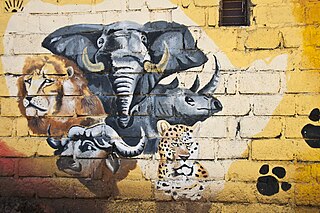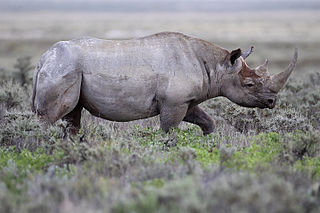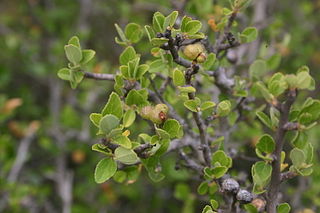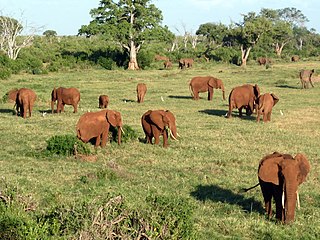
Odd-toed ungulates, mammals which constitute the taxonomic order Perissodactyla, are animals—ungulates—who have reduced the weight-bearing toes to three or even one of the five original toes. The non-weight-bearing toes are either present, absent, vestigial, or positioned posteriorly. By contrast, the even-toed ungulates bear most of their weight equally on two of the five toes: their third and fourth toes. Another difference between the two is that odd-toed ungulates digest plant cellulose in their intestines rather than in one or more stomach chambers as the even-toed ungulates do.

In Africa, the Big Five game animals are the lion, leopard, rhinoceros, elephant, and Cape buffalo. The term was coined by big-game hunters, and refers to the five most difficult animals in Africa to hunt on foot, but is now also widely used by safari tour operators.

The black rhinoceros or hook-lipped rhinoceros is a species of rhinoceros, native to eastern and southern Africa including Angola, Botswana, Kenya, Malawi, Mozambique, Namibia, South Africa, Eswatini, Tanzania, Zambia, and Zimbabwe. Although the rhinoceros is referred to as black, its colours vary from brown to grey.

A rhinoceros, commonly abbreviated to rhino, is a member of any of the five extant species of odd-toed ungulates in the family Rhinocerotidae, as well as any of the numerous extinct species therein. Two of the extant species are native to Africa, and three to Southern Asia. The term "rhinoceros" is often more broadly applied to now extinct species of the superfamily Rhinocerotoidea.

Addo Elephant National Park is a diverse wildlife conservation park situated close to Port Elizabeth in South Africa and is one of the country's 20 national parks. It currently ranks third in size after Kruger National Park and the Kgalagadi Transfrontier Park.

The Maputaland-Pondoland bushland and thickets is one of the ecoregions of South Africa. It consists of the montane shrubland biome.

The East Sudanian Savanna is a hot, dry, tropical savanna ecoregion of Central and East Africa.

The eastern black rhinoceros is also known as the East African black rhinoceros or eastern hook-lipped rhinoceros. It is a subspecies of the black rhinoceros. Its numbers are very low due to poaching for its horn and it is listed as critically endangered.

The western black rhinoceros or West African black rhinoceros is an extinct subspecies of the black rhinoceros. It was declared extinct by the IUCN in 2011. The western black rhinoceros was believed to have been genetically different from other rhino subspecies. It was once widespread in the savanna of sub-Saharan Africa, but its numbers declined due to poaching. The western black rhinoceros resided primarily in Cameroon, but surveys since 2006 have failed to locate any individuals.

The south-central black rhinoceros or south-central hook-lipped rhinoceros is a subspecies of the black rhinoceros. In keeping with the rules of zoological nomenclature, the south-central black rhinoceros should be known as Diceros bicornis keitloa, a nomen novum. Although it is the most numerous of the black rhino subspecies, it is nevertheless designated as critically endangered on the IUCN’s red list. Like other black rhino subspecies, it has a prehensile lip and lives in savanna habitat.

The south-western black rhinoceros is a subspecies of the black rhinoceros, living in southwestern Africa. It is currently listed as near threatened by the IUCN. The biggest threat towards the subspecies is illegal poaching.

The southern black rhinoceros or Cape rhinoceros is an extinct subspecies of the black rhinoceros that was once abundant in South Africa from the Cape Province to Transvaal, southern Namibia, and possibly also Lesotho and southern Botswana. It was brought to extinction by excessive hunting and habitat destruction around 1850.

The Chyulu Hills is a mountain range in Makueni County, South Eastern Kenya. It forms a 100 kilometre long volcanic field in elongated NW-SE direction. Its highest peak is 2188 metres high.

The Albany thickets is an ecoregion of dense woodland in southern South Africa, which is concentrated around the Albany region of the Eastern Cape.

Ruma National Park is the only terrestrial park in Kenya's Nyanza Province. Dubbed the "Last Retreat of the Roan Antelope", the park protects the only indigenous population of rare roan antelopes within Kenya. At present, the population is on the verge of extinction with individual populations numbering approximately 40. The park was established in 1966 as Lambwe Valley Game Reserve. It was later renamed “Ruma” after one of Kenya's most powerful wizard, the much feared Gor Mahia who lived around the park. The park is located in the vast Lambwe Valley.

Grewia robusta is a multi-stemmed shrub or small tree, up to 3 m high, endemic to the semi-desert Karoo of South Africa, and very similar to Grewia occidentalis. It is one of some 325 species of Grewia in the family Malvaceae, and having a tropical African, Asian and Australian distribution. It is found in the arid regions of the Karoo and Eastern Cape, and generally prefers growing among dry scrub on rocky hillsides.

The Northern Acacia-Commiphora bushlands and thickets are a tropical grasslands, savannas, and shrublands ecoregion in eastern Africa. The ecoregion is mostly located in Kenya, extending north into southeastern South Sudan, northeastern Uganda, and southwestern Ethiopia, and south into Tanzania along the Kenya-Tanzania border.

Grewia hexamita, the giant raisin, is a species of flowering plant in the family Malvaceae, native to Mozambique and adjoining countries. It is a large tree for a Grewia, reaching 5 m (16 ft). It is the most preferred woody plant of African savanna elephants, who browse on it in all seasons, unlike even other species of Grewia.

















